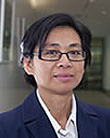full article:
This article describes a nurse practitioner (NP) model of practice, established to meet the primary healthcare needs of the residents of a remote tourist destination in Australia and the seasonal visitors to the region. As a nation, Australia offers universal health coverage to all citizens and permanent residents, regardless of location. This presents a number of challenges for health service providers located in remote areas where sparse resident populations experience large seasonal influxes of tourists{1, 2}. A particular focus of this article is the health needs of one group of tourists: the increasing number of retirees who are taking to the roads in caravans or motor-homes to visit popular tourist sites1,2. These 'grey nomads', as they are colloquially known, often have chronic health conditions, including hypertension, diabetes and cardiac disease, and seek out health care on their travels2. Many remote communities do not have the services or capacity to provide the health care required by this group of older people. The community-based, clinic-located NP model of practice provides an innovative means of overcoming the challenges of providing comprehensive health care in remote locations and meeting the diverse health needs of the grey nomads.
Background
As with other Western nations across the globe, the population of Australia is ageing: more than 14% of a population of some 23 million are aged 65 years or older, with this proportion projected to increase to 21-23% by 20413. One reason for this demographic is the increased life expectancy of Australians, the result of improved living conditions and the advances made in health promotion, illness prevention and treatment options over the past hundred or more years4,5. A second reason for this demographic is the ageing of the 'baby boomers'6,the generation born after the Second World War, when there was a sharp increase in the birth rate.
Not all older Australians are grey nomads - indeed, the evidence suggests that only 2% of Australia's population spend any length of time touring the continent7. Even so, there is evidence to suggest that older people are taking more than 200 000 caravanning trips for 6 weeks or longer each year, with approximately 70 000-80 000 caravans or motor-homes touring the country at any one time1. Reasons for this trend include, but are not limited to, the relative wealth of older Australians, with approximately 25% of Australia's disposable income and 40% of its current wealth held by people aged 55 years or older5,8. Such wealth has led some grey nomads to make the decision to minimise cash savings by purchasing a caravan or motor-home, thereby maximising eligibility for government benefits7.
In addition to the possible advantages achieved from the purchase of a caravan or motor-home and subsequent travel around Australia, benefits for older people include the purpose or meaning in life created from travelling post-retirement9,10. Grey nomads describe taking part in social and sporting activities with other travellers, and forming friendships and social networks that are supportive and long-lasting during the journeying and sojourning phases of their travel9. Grey nomads report that their travels have motivated them to learn to use online technologies, to maintain contact with family and friends while travelling and to support their search for the best places to stay while on the road9,11.
Other benefits include those generated for the communities through which the grey nomads travel, such as the economic boost created when the older people spend money on food, clothes, fuel, and other items to support their daily activities of living during the course of their journey5,11,12. Indeed, the 'tourist dollar' is becoming increasingly important to the economies of remote communities; for example, some $228 million is generated annually by tourists who visit the Kimberley region of in north-western Australia13. Tourism, then, is supporting the sustainability of some remote communities.
While many grey nomads fit the popular, perhaps stereotypical image of 'cashed-up' retirees who travel around Australia while they are still healthy enough to enjoy the lifestyle, not all grey nomads contribute to the wealth of the communities they visit. For example, some commentators argue that the economic benefits reaped from older tourists visiting small towns and communities may not cover the cost of the services they consume11. This is because many grey nomads prefer to cook their own meals rather than dine out in the towns they visit, and to camp overnight on the side of the road rather than pay to stay in a caravan park or motel14,15. On the other hand, there is an expectation on the part of the many grey nomads that the services they need, including health services, will be available as required, regardless of location or capacity of the local communities to provide these health services11. This generates a number of challenges for health services providers with the brief to meet the health needs and preferences of all consumers who present to them for help.
The health profile of grey nomads
The demographics of grey nomads are not representative of all older Australians, with most grey nomads being white Anglo-Australians in their early to mid-60s and in heterosexual relationships (with the woman younger than the man)16. Generally speaking, the health profile of grey nomads is similar to that of the wider population of Australians aged 65 years or older, and includes high rates of chronic disease and medication use17. For example, in the 2007-08 National Health Survey, almost all Australians aged 65 years and older reported at least one long-term health condition, with more than 80% of people in this age group reporting three or more long-term conditions, including hypertension, diabetes and cardiac problems18. While such conditions do not necessarily preclude travel5, questions about their management and the appropriateness of services delivered by health professionals in remote destinations should be raised by the older person who is travelling for long periods.
These issues are highlighted by findings of a case study of the Kimberley region17. Each year, approximately 265 000 tourists visit this region, thereby increasing the population more than sixfold, with those aged 65 years or more representing approximately 13% of all visitors17. Some 260 travellers, aged 50 years or more and staying in motor-homes or tents at Fitzroy Crossing, were surveyed in 2005, with 68% identified with chronic diseases, hypertension the most prevalent. The majority of participants (61.9%) were taking regular medications, of which only half were carrying enough to last them the duration of the trip. As few as 9% had a health summary from their usual general practitioner (GP), and 39.2% were not adequately vaccinated according to recommendations made by the Australian National Health and Medical Research Council. The researchers went on to conduct telephone interviews of medical practitioners in the Kimberley region who provided primary health care to residents and travellers, and nurses who delivered services from remote clinics with no resident medical practitioner17. Of the 40 medical practitioners and 24 nurses interviewed, 95% indicated that it would be helpful if the grey nomads carried a health summary that included an active problem list, and past history of health conditions, current medications and allergies.
Findings from the Kimberley study raised a number of questions about how best to meet the health needs of the grey nomads: for example, how can health service organisations in rural and remote Australia rise to the challenges presented by the grey nomad phenomenon? In the light of the difficulties that continue to be experienced by health service organisations to attract health personnel, particularly medical practitioners, to work in rural and remote Australia19, what new or innovative models of health care can be developed to meet the health needs of this older group of people?
Aged-care nurse practitioner models of practice
An NP in Australia is a registered nurse with at least 5 years practice as an advanced clinician, an accredited Master's level education, and endorsement by the Nursing and Midwifery Board of Australia to practice autonomously in expanded and extended clinical roles20,21. The practice of the NP includes conducting complex and comprehensive health assessments, delivering a range of interventions and coordinating care; prescribing, titrating and/or ceasing medicines; ordering diagnostic investigations; and directly referring patients to other health professionals22. Another significant component of the work of NPs is their close working relationship with medical practitioners, allied health professionals and other members of the multidisciplinary health team to ensure optimal communication between all stakeholders23.
To help address the health issues arising from the ageing demographic of the nation's population, the Australian Government provided $18.7 million in 2011 to establish a 4-year initiative, the Nurse Practitioner - Aged Care Models of Practice Initiative (NP Initiative)5. The first aim of the NP Initiative was to support the development of effective, sustainable and economically viable aged-care NP models of practice across Australia; the second aim was to facilitate the growth of the aged-care NP workforce; the third aim was to improve access for older people to primary health care for consumers of residential and community aged care services24. With the role of the NP in Australia still in its infancy when compared to, for example, that of the USA25, the NP Initiative was viewed as an important means for supporting the trajectory of the development of the NP role in the aged-care sector. This is because the NP Initiative enabled the implementation of 29 NP models of practice across remote, rural, urban and metropolitan locations in each of the Australian states and territories.
Funds were also provided by the Australian Government for a large-scale evaluation (NP Evaluation) of the effectiveness of the participating models26. Aims of the NP Evaluation included comparing each of the aged care models to the aims of the NP Initiative - assessing resource requirements and costs; analysing the effectiveness of each model; exploring the experiences of consumers/patients and providers of the delivery of the models; assessing viability and sustainability of NP models; and evaluating impact on quality of care and health outcomes24. This article supports achievement of the first aim of the evaluation, which compared each of the aged care models with the aims of the NP Initiative. Based on the premise that such comparisons cannot be undertaken until the models themselves are explained, the article provides a comprehensive description of a community-based clinic-located NP model, with consideration given to the connections between this particular model of practice and theoretical composition of nursing models more generally. Findings are also used to further support theoretical development of the theory related to models of practice and/or health care.
Models of practice defined: Clearly delineated models of practice in the healthcare arena provide a purposeful framework - including a theoretical basis, standards, evidence-based practices, key performance indicators and measurable outcomes - to guide the work of health professionals27. Specifically, nursing models of practice, which are a type of healthcare model, are used to manage or organise nursing teams, including the way(s) in which nurses work, together with the resources they utilise as part of this work, and thereby meet the health needs and preferences of the consumer28,29.
Nursing models of care must be flexible enough to allow for adaptation across a range of settings, and rigorous enough to demonstrate a number of key components, including a well-defined theoretical framework; principles to support clinical governance; a strategy to guide implementation and ongoing operation; together with a clear plan for review, evaluation and continuous improvement of the model30. There are a number of benefits to nurses implementing well-articulated, rigorous models of practice. The first of these benefits includes the development of more proactive and less reactive approaches for nurses to their work31. The second of the benefits is the higher personal value placed on their work by nurses, when they work within such models31. Third, clearly delineated nursing models lead to raised awareness for other members of the multidisciplinary team in relation to the work or practice of nurses, giving rise to reduced interdisciplinary conflict, an improved and common understanding of the anticipated outcomes of the work of the nurses, and enhanced continuity of the care provided by the multidisciplinary health team32,33.
The NP Initiative enabled the development and evaluation of nursing models specific to the NP, as well as supporting the development of the NP role in the aged-care sector. Subsequent sections of this article explicate the key components of the community-based, clinic-located NP model developed to meet the health needs of a remote community with no resident GP, as well as the health needs of grey nomads passing through that remote community.
The NP Evaluation was a complex, large-scale, national study, conducted using a multi-methods approach that comprised three different strands: quantitative, qualitative and case study. To obtain the detailed and comprehensive range of findings that are required to explain the 'real life' nature of the NP models of practice, results from each of these strands were considered separately as well as together through a process of triangulation. Explanations of the quantitative and qualitative components of this large-scale study can be found in related articles24,34. This article forms one part of the findings generated through the case study component of the evaluation.
Case study design
Case study designs enable the in-depth investigation of a 'case' - a person, organisation or phenomenon, or a group of persons, organisations or other phenomena35,36. Located within a social constructionist paradigm, a strength of the case study design is its flexibility and pragmatism - case studies provide the framework to support the systematic nature of an investigation, while at the same time supporting the flexibility necessary when collecting data from multiple sources in authentic, complex and/or 'real life' contexts37. Indeed, case study analyses are often used to investigate phenomena that are too complex for survey, experimental or humanist designs36.
An important focus of case study analyses is the context of the case, including the way in which that context influences the phenomenon under investigation38. This suggests why the case study research design is particularly well suited to the examination of the processes and outcomes of healthcare organisations, where data can be obtained from a range of sources and perspectives, and synthesised to develop an explanation of what is occurring39,40. Consideration can also be given to the way in which the case is affected by its context, and what the case adds to the theory by which it is examined36.
The case study design has a number of weaknesses. Perhaps the main weakness is that findings have limited generalisability - this is because the findings relate to the particular phenomenon under investigation, as it occurs within the specific case study context40. Findings are nevertheless transferable to other, similar contexts - the principles derived from a case study investigation can be taken and tested in other contexts, with findings used to develop related theory35.
Reasons for choosing a case study design for this investigation: The case study design was chosen to examine the community-based, clinic-located NP model of practice because of the inherent complexity of this 'case'. With regard to the NP Evaluation, meeting the aims of the study required development of clearly explicated examples of NP models of practice, for utilisation by other NPs as well as health service organisations24. Specifically, the NP Evaluation involved analysis of 29 NP models that were established in remote, rural, urban and metropolitan locations across Australia. These 29 models fall into five main categories: NPs working in residential aged-care facilities (10 different sites), NPs working in GP business settings (five different sites), NPs working in community-based clinics (four different sites), NPs working as sole traders (four different sites) and NPs working in state-sponsored roles (six different sites). The focus of this article is the NP model utilised in a community-based clinic, with the clinic that is described located in a remote but popular tourist destination in Australia.
Data collection for case study strand of NP Evaluation: Data for the case study strand of the research were collected from a range of sources. These sources included comprehensive descriptions of the NP models, synthesised from observational notes developed by researchers during thorough inspections of the sites, as well as information derived from the in-depth interviews of NPs, managers, medical practitioners and allied health workers, undertaken as part of the qualitative component of the evaluation. As already explained, these data were then examined in light of the theoretical components of nursing models of practice more generally, with comprehensive descriptions of each of these components developed to align with the overall and defining framework or structure.
Ethics approval
NP Evaluation as a whole - that is, all three strands of the research - received approval from the human research ethics committee of the home institution (University of Canberra HREC 11-149), together with some 20 other human research ethics committees across Australia. In addition, full support for the independent evaluation was provided by directors, managers and/or governance committees of the participating organisations. All participants - NPs, managers, associated medical practitioners, consumers/patients and carers - were volunteers, recruited by way of flyer promotion, email advertisement and/or word of mouth. Information about the study, including a description of its aims and objectives, and clarification regarding each person's right to withdraw after making the decision to participate, was also provided to each potential participant. Prior to participation, written consent was given by each participant.
To reiterate, findings reported in this article relate to a community-based, clinic-located NP model of practice, established in a remote tourist destination where there is no resident GP. Prior to implementation of this project, health services in this location were delivered by a remote area nurse (RAN). However, the RAN model was limited by the scope of practice of the RAN, which is not as extensive as that of the NP. For example, the NP is endorsed to work autonomously to order diagnostic tests, prescribe or titrate medicines, and make referrals to specialist medical practitioners. Implementation of the community-based, clinic-located NP model in this region, then, provided residents and tourists alike with a higher level of and more comprehensive approach to the delivery of health care, thereby reducing the potential need for consumers to travel long distances to consult a GP.
For this case study analysis, data was initially used to develop a narrative description of the location and role of the NP (Box 1). This narrative description provided a first step to the process of distilling the information required to define the community-based, clinic-located NP model.
The data were then analysed and synthesised in light of the theoretical components of nursing models of practice - in this case, those identified by Hungerford30. Synthesis of the details of these theoretical components included the use of four major headings, with these headings used to guide categorisation of the data: 'Theoretical, legislative and ethical framework', 'Governance', 'Implementation and operationalization', and 'Evaluation and/or review'. With regard to 'Governance', a number of subheadings were likewise derived from the findings: 'Implementation strategy', 'Ongoing governance', 'Management' and 'Formal communication strategy'. For the heading 'Implementation and operationalization', the subheadings were 'Influence of context', 'Needs and preferences of target population', 'Work of the NP', and 'Ongoing education about the NP model of practice'. Finally, under the heading 'Evaluation and/or review', the subheadings were 'Evaluation' and 'Ongoing review'. It is important to highlight the addition of 'Influence of context' as a component of a model of nursing. The inclusion of this component, in addition to those previously identified30 is justified in subsequent paragraphs and also the discussion section of this article.
An outline of each of the components of the NP model are provided in Table 1. Of particular note is the theoretical framework of the NP model, which privileges the concepts of health promotion and illness prevention41, derived from social cognitive theory42. This theory posits that behaviours, and the outcomes of these behaviours, can be changed when people observe the behaviours of others, through social interaction, experience, education or the mass media, and go on to imitate these behaviours43. Social cognitive theory and the health promotion model were identified as strongly influencing the practice of the NP, because her work was predominantly aimed at building community capacity to optimise health and wellbeing by changing health behaviours, in the process of providing front-line primary healthcare services to local residents as well as seasonal tourists.
Another major aspect of the findings is the way in which the context of the clinic itself was identified as affecting the practice of the NP. For example, the remoteness of the location of the small community in which the clinic was located influenced the health needs and preferences of the population, with rural and remote Australians known for their self-reliance and preference to stay in the local community rather than travel long distances for treatment of relatively minor conditions7. This remoteness, in turn, defined the work of the NP, including the need for her to make autonomous and independent decisions about a range of health conditions; to provide a range of services, including emergency care, acute care and chronic care; and to undertake activities related to health promotion and illness prevention. In addition, the location of the NP clinic influenced the nature of the support services that worked with the NP, including a range of fly-in and drive-in health professionals.
Box 1: De-identified case description of nurse practitioner's location and role
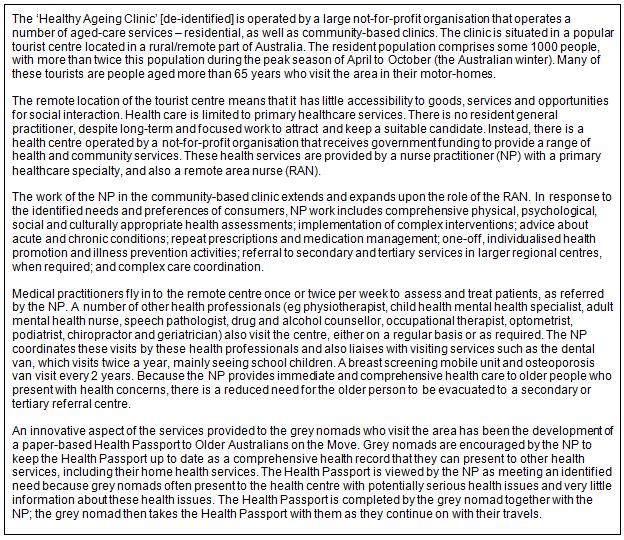 Box 2: Aged-care nurse practitioner model of practice: analysis of rural/remote community-based, clinic-located41-43
Box 2: Aged-care nurse practitioner model of practice: analysis of rural/remote community-based, clinic-located41-43
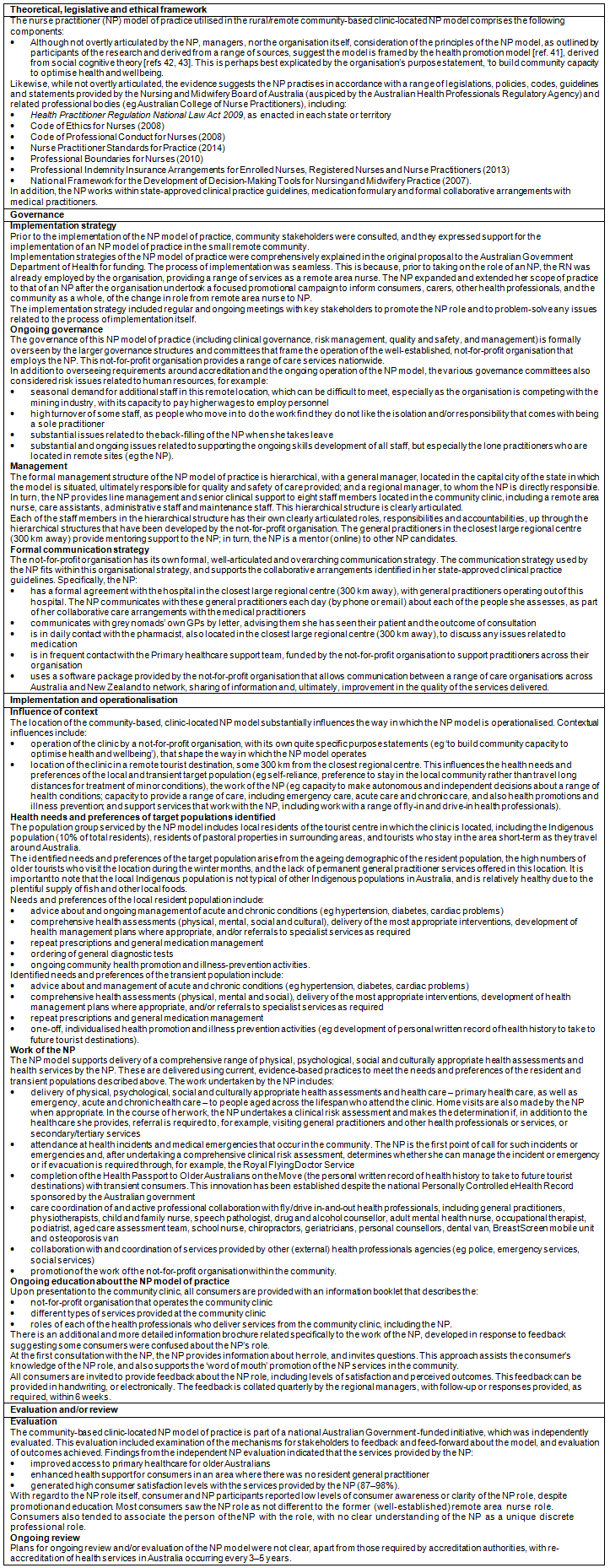
Discussion
The NP model of practice described in Table 1 was developed for the health needs of the remote populations, as well as for the seasonal tourists. This model has the potential to be implemented to meet the needs and preferences of consumers in a range of locations: remote, rural, urban and metropolitan. For this reason, it is necessary to consider not only the benefits of the NP model but also the challenges and limitations identified through the case study analysis. Such consideration allows health service organisations, and also NPs who utilise the clinic-located model, to build on the model's strengths, and develop options or solutions to overcome the model's potential challenges.
Benefits and enablers
The case study analysis indicated a number of benefits and enablers of the community-based, clinic-located NP model (Table 1). Some of these benefits operate at the local and state levels; for example, the model provides a means of delivering a range of timely health services where there is no resident GP and thereby minimises the requirement for people to travel to larger regional centres for treatment or hospitalisation for relatively minor conditions. Additionally, the delivery of health services in the community by a local NP, with an understanding of local needs and preferences, suggests that the health care provided would be more appropriate and/or sensitive to that community.
Perhaps the most noteworthy enabler for the NP model was the not-for-profit organisation responsible for establishing and sponsoring the model. Findings from the NP Evaluation overall indicated that a large organisational 'safety net' helped to support sustainability of the NP models generally, with the models that relied heavily upon payments from the Australian Government Medical Benefits Schedule (MBS) less likely to survive financially. For this NP model, the not-for-profit organisation was able to obtain funding from sources other than the MBS to cover NP salary and associated on-costs. Additionally, the organisation maintained the community-based clinic itself, including the provision of the materials necessary for the day-to-day operation of the services; and provided management, administrative and business support to support the rigor of the NP model, including mobile digital hardware and software so that the NP can connect to existing communication and health record-keeping systems. In relation to clinical governance, the organisation provided a ready-made framework - including policies, procedures and protocols - into which the NP model was incorporated. This included providing the necessary quality and safety mechanisms, and allowing the NP to focus solely on the delivery of services.
Another enabler of the NP model was the strong and workable collaborative arrangements that were developed between the NP and the hospital in the closest regional centres, including associated GPs and other health professionals. Additionally, the NP model was supported in principle by local government. These relationships enabled a seamless continuity of care for people accessing the health services provided by health professionals who fly/drive into communities as required or, where necessary, the patient to fly out via the Royal Flying Doctor Service to access secondary or tertiary level services. The NP also provided ongoing care coordination to ensure the right service was delivered at the right time to the patient.
One possible reason for the strong relationships between the NP and other health professionals may be that the collaborative arrangements have been made with the publicly funded health service, rather than with individual health professionals. With acceptance of and support for the NP at the systems level, there was little room for or evidence of a 'turf warfare' between NPs and other health professionals, including medical practitioners. This situation stood in contrast to those reported by a substantial number of the NPs who participated in the evaluation utilising other NP models of practice in other locations.
Table 1: Benefits, enablers and challenges of the clinic-based nurse practitioner model
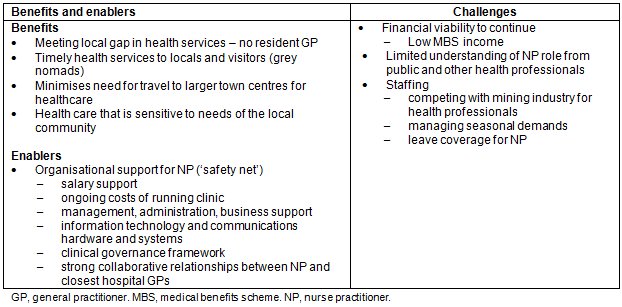
Challenges
Three major challenges were identified through the case study analysis. First, the viability of the NP model was challenged by issues with ongoing financial sustainability. At present, NPs have a limited access to the Australian Government MBS; for example, there are only four NP MBS items compared to hundreds of items available to GPs. NPs are currently paid less than half the amount of comparable GP time-based items (MBS item numbers 3, 23, 36, 44). GPs can also receive a benefit for bulk-billing concessional patients, visiting residential aged-care facilities, and after-hours consultations that NPs do not receive. Additionally, NPs generally, across the NP Evaluation, suggested that brief, time-based biomedical business models do not fit well with more holistic and comprehensive approaches taken by nurses when providing health care. While the not-for-profit organisation that employs the NP was able to access state government RAN funding to subsidise the NP salary, the relative new-ness of NP models in Australia has meant that other potential avenues for funding remain unexplored.
The second challenge relates to the understanding of community members, as well as other health professionals, of the expanded and extended scope of practice of the NP. As identified in Table 1, the not-for-profit organisation undertook a focused promotional campaign aimed at informing key stakeholder groups of the change from RAN to NP. The NP then continued to provide promotional information to those with whom she worked - patients, carers, community members and other health professionals. Even so, many of these stakeholders expressed confusion during the in-depth interviews about the difference between the roles of the RAN and NP. This suggested the ongoing need to educate people about the role of the NP, including the expanded scope of practice of the NP.
Connected to this challenge were those related to differentiating the person of the NP from the role of the NP. For example, while consumers expressed high satisfaction rates with the services received from the NP in the community-located clinic, there was some question about how these consumers differentiated the person and role. Was it the person - a popular community member - with whom the consumers felt satisfied, or was it the range of services provided by the NP? Can the person and the way in which they fulfil a professional role ever be truly separated? Answers to such questions may lie with clearer articulation of the model to all key stakeholders. Systems-driven health care has much better outcomes than services that rely upon individuals44. While consumers continue to associate the person in the NP role with the role itself, it will be difficult to develop the NP role in its own right.
The third challenge for the NP model involves staffing. As noted in Table 1 under the heading 'Governance', there was a seasonal demand for additional staff to support ongoing operation of the clinic; recruitment, however, proved difficult. Moreover, rates of staff turnover were high due to the exorbitant salaries paid to health professionals by the nearby mining companies. Such high turnover is not unusual in rural and remote locations across Australia45,46, with national and state governments alike continuing to search for sustainable solutions. For this reason, there was a need for the not-for-profit organisation that supports the NP model, together with other organisations that are considering setting up similar NP models of practice, to consider how best to provide support to the NP in the holiday peak season. This would include arranging for the back-filling of the NP position to enable the NP to take much-needed holidays, assured that the healthcare needs of the local community continue to be addressed.
Practice quandaries: At the micro level of service delivery, findings of the case study analysis raised questions about the decision made by the not-for-profit organisation and the NP to develop a paper-based Health Passport to Older Australians on the Move. This activity was viewed by the organisation as a useful means of addressing the need identified by medical practitioners and nurses alike for grey nomads to carry a health summary that included an active problem list, past history, current medications and allergies17. In addition, the NP working in this location reported finding the health needs of some grey nomads to be quite acute. There were four main reasons for this. First, these older tourists often avoided seeking out health care until health issues became acute, so that their travel would not be delayed. Second, the older tourists often set out on their trip without enough medications to last the duration of that trip. Third, the older tourists lacked the supports they relied on at home to maintain their health and wellbeing. Finally, the treatment the older tourists obtained while travelling was often provided in isolation, without history, and so was sometimes counter-productive. The Health Passport was identified as addressing such issues.
It could also be argued that the Health Passport duplicates the Personally Controlled eHealth Record sponsored by the Australian Government Department of Health - a national, online, secure record that is completed by the patient and made available to health professionals as permitted by the patient47. The Personally Controlled eHealth Record enables patients to actively engage in their own health care and work in partnership with health professionals to negotiate the health care they receive48. Online records cannot be accessed in many parts of rural and/or remote Australia, where internet availability is limited in some of the smaller townships and in emergency situations on remote roads. Even so, to avoid possible duplication of services, it would perhaps have been more useful to consider ways and means of using the eHealth Record and supporting the older tourists to transfer it temporarily to, for example, a paper-based form when travelling. Such a solution is supported by a range of researchers49,50, who argue that success of the Personally Controlled eHealth Record relies on acceptance by health professionals and a collaborative approach between all those involved. The NP in primary health care is well placed to encourage such acceptance and enable such collaboration.
Clarifying the model to all stakeholders: Findings from the analysis suggest the theoretical, legislative and ethical framework of the NP model, together with the ongoing strategy to review and/or evaluate the model, has still to be overtly articulated to all stakeholders by the NP and auspicing not-for-profit organisation. Such theoretical work may seem to be of little benefit to busy practitioners and managers. It is important to reiterate, then, that poor understanding of the model of practice utilised by nurses often leads to their work being limited by the dominant biomedical model, with its focus on illness and disease31. These potential limitations can be problematic in primary healthcare contexts. For example, the community-based, clinic-located NP model is theoretically framed by social cognitive theory42,43 and the health promotion model41 (Table 1), with such approaches providing a much broader scope than the biomedical model alone. For this reason, overt articulation to key stakeholders will maximise the effectiveness of the NP model.
It was noted in earlier sections of this article that nurses who are clear about the model of health care within which they work place a higher personal value on their role, are more consistent in their practice and are more likely to be strategic rather than reactive in their practice31. Similarly, clear articulation of the nursing model that is used to frame practice leads to patients and members of the multidisciplinary team placing a higher value on the aims, goals and contribution of nurses32,33. Finally, delineating nursing models of practice provides a necessary means for managers to identify the resources required to support the models, as well as to develop indicators of performance. This is particularly important because, arguably, it is only with demonstrable evidence of the achievement of key performance indicators, including health outcomes, that any nursing model, including NP models, will attract additional funding from governments and other stakeholders into the future.
Development of theoretical modelling
It has already been explained that analysis of the community-based, clinic-located NP model was guided by the essential components for nursing models30. The testing and development of connections between the theory and practice of the community-based, clinic located NP model suggests the need for an additional component that relates to the context of the nursing model, including the way in which context influences the model. Although implied by Hungerford30, who examined models of health care generally in the context of recovery-oriented mental health services, the importance of context was not explicitly identified as an essential component of a model of health care. More research is required to further test this theoretical addition; even so, findings from this study highlight the need to consider the influence of context upon the nursing models of practice, across diverse contexts. This, in turn, supports flexibility and also applicability of the models.
Figure 1 supports the ongoing building of the theory related to the essential components of nursing models of practice. The processes represented are important for three main reasons. First, they identify the essential components of nursing models of practice, thereby providing a systematic framework to guide the work of nurses. Second, the broken lines that differentiate each of the components, together with the circular direction of the arrows, illustrates how nursing models of practice are continually changing or adapting according to the imperatives of clinical governance, diverse contexts, needs and preferences of the patient, and the findings of regular evaluations and reviews. Finally, the broken lines and circular direction of the arrows emphasise that each component of the model will inevitably influence the other components. For this reason, nursing models of practice may be described as adaptive systems that rigorously guide the work of nurses, according to the context(s) in which they are located.
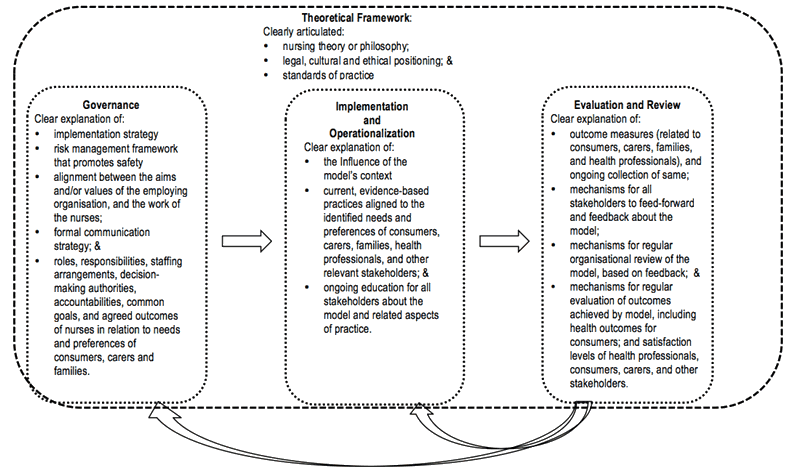 Figure 1: Essential components of a nursing model of practice.
Figure 1: Essential components of a nursing model of practice.
This article describes a community-based, clinic-located NP model of practice located in remote Australia. The main enabler of the community-based, clinic-located NP model was the sponsoring not-for-profit organisation, which provided pre-existing structures for clinical governance and general management, as well as funding. Other enablers were the collaborative agreements negotiated at a systems level between the NP, other health professionals, and a variety of service providers. Challenges to the model included the organisation's limited capacity to back-fill the NP for leave and professional development entitlements, and to obtain recurrent funding to sustain the model. Also identified was the need for the organisation to clearly explain the NP model and role, to provide understanding among key stakeholders of the services being delivered.
Findings from the case study analysis also enabled theoretical development of the NP model, and nursing models more generally. While the model was developed to meet the health needs and preferences of the local populations and seasonal tourists, findings of the analysis support transferability of the model to other clinic-located locations, with the principles identified providing an exemplar for other organisations and NPs to follow when establishing similar innovative and flexible models of health care to respond to the changing demand for service.
Acknowledgements
This article is partly based on information and/or data that draw on contract material developed by personnel of University of Canberra in relation to the research project entitled National Evaluation of the Nurse Practitioner - Aged Care Models of Practice Initiative, funded by the Australian Government. Thanks also to Sylvia Alston PhD, who assisted with the manuscript development.
References
1. Higgs P, Quirk F. 'Grey nomads' in Australia: are they a good model for successful aging and health? Annals of New York Academy of Sciences 2007; 1114: 251-257.
2. Raven M. The health of Grey Nomads: on the move and under the health sector radar. Australian Journal of Rural Health 2015; doi: 10.1111/ajr.12236.
3. Australian Bureau of Statistics. Who are Australia's older people? Reflecting a nation: stories from the 2011 Census. Cat. no. 2071.0. (Internet) 2012. Available: http://www.abs.gov.au/ausstats (Accessed 5 March 2015).
4. Brayley N, Obst PL. The Australian Grey Nomads - are they who we think they are? Enhancing formative research through the quantitative assessment of psychological constructs. Health Promotion Journal of Australia 2010; 21: 138-142.
5. Clark S, Davey R, Gibson D, Goss J, Hungerford C, Parker R. National evaluation of the nurse practitioner - aged care models of practice initiative: summary of findings. Canberra: Centre for Research and Action in Public Health, UC Health Research Institute, University of Canberra, 2015.
6. Jang S, Ham S. A double-hurdle analysis of travel expenditure: baby boomer seniors versus older seniors. Tourism Management 2009; 30: 372-380.
7. Davies A. On constructing ageing rural populations: 'capturing' the Grey Nomad. Journal of Rural Studies 2011; 27: 191-199.
8. Bauer I. Australian senior adventure travellers to Peru: maximising older tourists' travel health experience. Travel Medicine and Infectious Diseases 2012; 10: 59-68.
9. Hillman W. Grey nomads travelling in Queensland, Australia: social and health needs. Ageing and Society 2013; 33: 579-597.
10. Onyx J, Leonard R. The Grey Nomad phenomenon: changing the script of aging. International Journal of Aging and Human Development 2007; 64: 381-398.
11. Economic Development Committee. Inquiry into developing Queensland's rural and regional communities through grey nomad tourism. Report no. 5. Economic Development Committee. Brisbane: Government of Queensland, 2011.
12. Mahadevan R. Understanding senior self-drive tourist in Australia using a contingency behaviour model. Journal of Travel Research 2014; 53: 252-259.
13. Cridland SC. An analysis of winter movement of grey nomads to northern Australia: planning increase for senior visitation. PhD thesis, Faculty of Science, Engineering and Information Technology, James Cook University. (Internet) 2008. Available: http://researchonline.jcu.edu.au/7901/2/02whole.pdf (Accessed 5 March 2015).
14. Australian Bureau of Statistics. Position paper - ABS review of Counting the Homeless methodology. (Internet) 2011. Cat. no. 2050.0.55.002. Available: http://www.abs.gov.au/ausstats (Accessed 5 March 2015).
15. Department of Resources, Energy and Tourism. Tropical north Queensland repositioning study, final report and recommendations, February 2009. Brisbane: Kleinhardt Business Consultants, 2009.
16. Erny-Albrecht K, Brown L, Raven M, Bywood P. Fly-in fly-out/drive-in drive-out practices and health service delivery in rural areas of Australia. (Internet) 2014. Available: http://www.phcris.org.au/publications/policyreviews/report.php?id=8425 (Accessed 5 March 2015).
17. Tate J, Mein J, Freeman H, Maguire G. Grey nomads - health and health preparation of older travellers in remote Australia. Australian Family Physician 2006; 35: 70-72.
18. Australian Bureau of Statistics (ABS). National Health Survey: summary of results, 2007-2008. Cat. no. 4364.0. Internet (2009). Available: http://www.abs.gov.au/ausstats (Accessed 5 March 2015).
19. Humphreys J, McGrail M, Joyce C, Scott A, Kalb G. Who should receive recruitment and retention incentives? Improved targeting of rural doctors using medical workforce data. Australian Journal of Rural Health 2012; 20: 3-10.
20. Clark S, Parker R, Prosser B, Davey R. Aged care nurse practitioners in Australia: evidence for the development of their role. Australian Health Review 2013; 37: 594-601.
21. Driscoll A, Worrall-Carter L, O'Reilly J, Stewart S. A historical review of the nurse practitioner role in Australia. Clinical Excellence for Nurse Practitioners 2005; 9: 141-152.
22. Nursing and Midwifery Board of Australia. Nurse practitioner standards for practice. (Internet) 2013. Available: http://www.nursingmidwiferyboard.gov.au (Accessed 5 March 2015).
23. Schadewaldt V, McInnes E, Hiller J, Gardner A. Investigating characteristics of collaboration between nurse practitioners and medical practitioners in primary healthcare: a mixed methods multiple case study protocol. Journal Advanced Nursing 2014; 70: 1184-1193.
24. Prosser B, Clark S, Davey R, Parker R. Developing a public health policy-research nexus: an evaluation of nurse practitioner models in aged care. Evaluation and Program Planning 2013; 40: 55-63.
25. Turner C, Keyzer D, Rudge T. Spheres of influence or autonomy? A discourse analysis of the introduction of Nurse Practitioners in rural and remote Australia. Journal Advanced Nursing 2007; 59: 38-46.
26. Clark S, Parker R, Davey R. Nurse Practitioners in aged care: documentary analysis of successful project proposals. Qualitative Health Research 2014; 24: 1592-1602.
27. Davidson P, Halcomb E, Hickman L, Phillips J, Graham B. Beyond the rhetoric: what do we mean by a 'model of care'? Journal Advanced Nursing 2006; 23: 47-55.
28. Fernandez R, Johnson M, Tran DT, Miranda C. Models of care in nursing: a systematic review. International Journal of Evidence Based Healthcare 2012; 10: 324-337.
29. Fowler J, Hardy J, Howarth T. Trialing collaborative nursing models of care: the impact of change. Australian Journal Advanced Nursing 2006; 23: 40-46.
30. Hungerford C. Recovery as a model of care? Insights from an Australian case study. Issues in Mental Health Nursing 2014; 35: 1-9.
31. McAllister M, Moyle W. An exploration of mental health nursing models of care in a Queensland psychiatric hospital. International Journal of Mental Health Nursing 2008; 17: 8-26.
32. Queensland Health. Queensland plan for mental health 2007-2017. Brisbane: Government of Queensland, 2007.
33. West Australian Health. Model of care overview and guidelines: ensuring people get the right care, at the right time, by the right team and in the right place. Perth: Government of Western Australia, 2007.
34. Hungerford C, Prosser B, Davey R. The key role of nurse researchers in the evaluation of Nurse Practitioner models of practice. Research and Theory for Nursing Practice 2014; 29: 214-225.
35. Yin R. Case study research: design and methods. 4th Ed. Thousand Oaks, CA: Sage, 2009.
36. Radley A, Chamberlain K. The study of the case: conceptualising case study research. Journal of Community & Applied Social Psychology 2012; 22: 390-399.
37. Payne S, Field D, Rolls L, Hawker S, Kerr C. Case study research methods in end-of-life care: reflections on three studies. Journal Advanced Nursing 2007; 58: 236-245.
38. Sangster-Gormley E. How case study research can help to explain implementation of the nurse practitioner role. Nursing Research 2013; 20: 6-11.
39. Johnston A. To case study or not to case study: our experience with the Canadian government's evaluation practices and the use of case studies as an evaluation methodology for First Nations programs. Canadian Journal of Program Evaluation 2013; 28: 21-42.
40. Crowe S, Cresswell K, Robertson A, Huby G, Avery A, Sheikh A. The case study approach. BMC Medical Research Methodology 2011; 11: 100.
41. Pender N, Murdaugh C, Parson M. Health promotion in nursing practice. 5th Ed. Upper Saddle River, NJ: Prentice Hall, 2006.
42. Bandura A. Self efficacy: toward a unifying theory of behavioural change. Psychological Review 1997; 84: 191-215.
43. Bandura A. Social foundations of thought and action: a social cognitive theory. Upper Saddle River, NJ: Prentice Hall, 1985.
44. Kitson A. The need for systems change: reflections on knowledge translation and organizational change. Journal Advanced Nursing 2009; 65: 217-228.
45. Mills J, Birks M, Hegney D. The status of rural nursing in Australia: 12 years on. Collegian 2010; 17: 30-37.
46. Weymouth S, Davey C, Wright J, Nieuwoudt L, Barclay L, Belton S, et al. What are the effects of distance management on the retention of remote area nurses in Australia? Rural Remote Health (Internet) 2007; 7: 652. Available: www.rrh.org.au (Accessed 31 March 2016).
47. Australian Government Department of Health. eHealth: the personally controlled eHealth record system. (Internet) 2014. Available: http://eHealth.gov.au (Accessed 5 March 2015).
48. Pearce C. Bainbridge M. A personally-controlled electronic health record for Australia. Journal of the American Medical Informatics Association 2014; 21: 707-713.
49. Kerai P, Wood P, Martin M. A pilot study on the views of elderly regional Australians of personally controlled electronic health records. International Journal of Medical Informatics 2014; 83: 201-209.
50. Knight A, Szucs C, Dhillon M, Lembke T, Mitchell C. The eCollaborative: using a quality improvement collaborative to implement the National eHealth Record System in Australian primary care practice. International Journal of Quality in Health Care 2014; 26: 411-417.


